  |
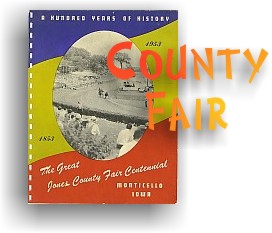 |
|||
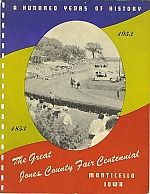
|
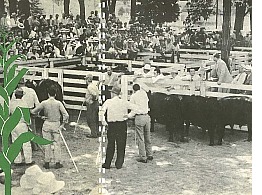 Early in the morning, the new fall sun up but a short time, clouds of dust could be seen rising along country roads as horse drawn family vehicles from surrounding farms and neighboring towns began the exciting trek to Monticello and the Great Jones County Fair. Lone horsemen, buckboards, and lumbering two and four-horse wagons overflowing with family, kinfolk, baskets of chicken, mountains of pie—all were headed for the pleasure and excitement that brought a glorious climax to the end of summer and harvest. Early in the morning, the new fall sun up but a short time, clouds of dust could be seen rising along country roads as horse drawn family vehicles from surrounding farms and neighboring towns began the exciting trek to Monticello and the Great Jones County Fair. Lone horsemen, buckboards, and lumbering two and four-horse wagons overflowing with family, kinfolk, baskets of chicken, mountains of pie—all were headed for the pleasure and excitement that brought a glorious climax to the end of summer and harvest. | |||
 Tuesday had been Entry Day. Perspiring farmers had driven, prodded and vocally persuaded the pride of their livestock to security in the Fair pens. The ladies of Jones County and the nearby territory had breathed nervously 'til the last carefully wrapped Battenburg doily and the last embroidered underwear set were carefully encased on display. The hand painted jardinière was placed intact in Floral Hall. The multitudinous jars of piccalilli, butters and preserves waited, glistening, in competition. Tuesday had been Entry Day. Perspiring farmers had driven, prodded and vocally persuaded the pride of their livestock to security in the Fair pens. The ladies of Jones County and the nearby territory had breathed nervously 'til the last carefully wrapped Battenburg doily and the last embroidered underwear set were carefully encased on display. The hand painted jardinière was placed intact in Floral Hall. The multitudinous jars of piccalilli, butters and preserves waited, glistening, in competition. |
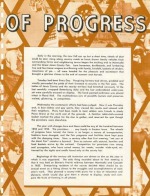 | |||
| Wednesday the contestants' efforts had been judged. Now it was Thursday and, in best clothes and gay spirits, they viewed the results and relaxed with their neighbors. Plans had been made to meet seldom seen friends in shady Picnic Grove at the north end of the grounds. A familiar table-cloth-covered basket marked the place for the clan to gather, and reserved the spot though the picnickers were elsewhere.
The year with changes here and there could be any of the hundred between 1853 and 1953. The picnickers . . . any family in Eastern Iowa. The wheels of progress have turned, the horse is no longer a means of transportation, fashions have changed, and the Fair programs and facilities have kept pace with the changing times. Now, a century after that first meeting, "see you at the Monti Fair" remains a byword. Sure as autumn rolls around, families and food baskets arrive by the carload. Competition for premiums runs strong and youngsters, who have saved money for weeks, wander wide-eyed, entranced by the sights and smells found only at the county fair. Beginnings of this century old institution are almost as dim as the year in which it was organized. The only thing recorded about its first meeting is that it was held on Bowen's Prairie midway between Monticello and Cascade in 1853. Enterprising residents of the county decided there should be an annual event as a fitting climax to the struggles and accomplishments of each year's work. They planned a county-wide picnic for a day of relaxation and pleasure, which would also give them a chance to display, study and compare the fruits of farming in all phases. |

|
|||
 From such humble beginnings evolved a county fair of national renown a hundred years later . . . the first county fair in Iowa to successfully live out its First Centennial. History is clouded by passing time, and few records or memories exist of such early days, other than casual mention by newspapers or occasional reference in yellowed letters. Even these written accounts differ from each other. From such humble beginnings evolved a county fair of national renown a hundred years later . . . the first county fair in Iowa to successfully live out its First Centennial. History is clouded by passing time, and few records or memories exist of such early days, other than casual mention by newspapers or occasional reference in yellowed letters. Even these written accounts differ from each other.
According to one such letter written in 1875 recalling "old times" the second meeting of the fair was held in Rome township, on a site near Olin. "The most I remember about the fair," the writer asserted, "is that the date was September, 1854. The region was then a wild waste dotted here and there with small hamlets, and the results of the fair were not dazzling." But it must have been a success in some way, at least, for it reached such proportions as to disturb the quite of the village. ". . . I was quite ill at the time and confined to my bed," continued the letter writer. "I was much annoyed by the number of guests at our house and still more by the unearthly noises accompanying the festivities. It lasted two or three days, but at last came to an end, to my great joy. However, I believe it was thought at the time worthy of the county." Worthy enough, for in spite of the correspondent's bitterness, the next year, 1855, the Fair was set up in Anamosa, then a village of thirty buildings. This was the first exhibit in the county about which records were kept. Practically all of the exhibits were agricultural. A few stakes connected with rope near the site of the present Iowa Mens Reformatory held the livestock exhibits, which consisted of several cows of common breed, a few horses and some sheep. Household and garden departments were represented by a few blankets and quilts displayed in the old courthouse along with some sorghum molasses, vegetables and a dozen Iowa grown apples. A newspaper of the day reported an average attendance of forty people on the grounds at a time. After a successful 1856 Bowen's Prairie exhibition, the Jones County Agricultural Society evidently took heart, for it again scheduled the 1857 meeting at Anamosa and awarded to James Peet the magnificent premium of $10 for the best cultivated farm in the county. Though other premiums were much smaller, they still totaled $197, so receipts of $43 from memberships and $97 from donations fell quite short. "This," a newspaper predicted, "will only create further dissension and rivalry between the county seat and the neighboring village to the north." However, the Fair had come to stay, and steps were taken by the Society to establish the fair on permanent exhibition grounds, complete with graded race track, near Anamosa. Here, the Society felt, was the place to build a real county fair, with all the trimmings. Their optimism was well founded, for advances were evidenced in all departments. "Tom Hyer," a race horse from Cedar Rapids was on the grounds, and caused considerable excitement, for few people at that time had ever seen a real race horse. Yet before many years racing was one of the major events of the county fair. Agricultural exhibits were still the mainstay of the 1863 fair. J. A. Penniman won $5 for the best yoke of oxen; C. T. Lampson won $5 for the best trotting horse and J. M. Peet's farm was again awarded $5 as the best farm. Finances of the Fair made advances, too. Premiums paid and contingent expenses amounted to $420.90. Receipts from memberships were $221, which together with state aid of $200, left a balance of 10 cents on hand. |
||||

|
 At the Anamosa fair of 1865, exhibits reflected the self-reliance of these early settlers. R. A. Rynerson of Bowen's Prairie, who was the owner of 800 apple trees, 300 of which were bearing, showed the largest assortment of apples. There were many cheese displays and S. G. Whitney earned an award for seven kinds of grapes. William Brazelton of Bowen's Prairie won $2 for his entry of home made cloth, and William Benadom won for the best straw hat specimen. Two premiums were awarded the puzzling entries of "54 fine Vermont Bucks" and J. A. Palmer's Artificial Mice. Perhaps early Jones County Fair exhibitors wanted to demonstrate that nothing was impossible. At the Anamosa fair of 1865, exhibits reflected the self-reliance of these early settlers. R. A. Rynerson of Bowen's Prairie, who was the owner of 800 apple trees, 300 of which were bearing, showed the largest assortment of apples. There were many cheese displays and S. G. Whitney earned an award for seven kinds of grapes. William Brazelton of Bowen's Prairie won $2 for his entry of home made cloth, and William Benadom won for the best straw hat specimen. Two premiums were awarded the puzzling entries of "54 fine Vermont Bucks" and J. A. Palmer's Artificial Mice. Perhaps early Jones County Fair exhibitors wanted to demonstrate that nothing was impossible.
The first recorded racing purse was won by "Buckskin," a Dubuque horse who ran against C. E. Wales' "Peavine." "Buckskin" earned $100 for its owner with a 2:44½ time. In spite of the distraction of the Civil War, $149.50 was left in the treasury, when the books were closed. President Joseph Tryon called attention to the fair of 1866 by the following announcement: "To the Citizens of Jones County and Vicinity: Recollecting our Agricultural Fair comes off October 3, 4 and 5th, we hope the examining committee will be on hand at 9 a.m., the second day. Dr. Blakeslee will be there with a large number of Chester White hogs and pigs and it is well worth your time to go and see them. (Well, the doctor is some on hogs.) Fowler of the Fisher House gives a magnificent ball Friday evening for the lovers of Dancing." The 1866 fair was as Josh Billings put it "a great success as an agricultural hoss trot." On Thursday a trotting race for the County Purse of $100 first money and $50 for second, resulted in Charles Wales' Peavine so out-distancing G. S. Eastman's Lightfoot and H. Lamson's horse Lamson that it won both first and second money in accordance with the track rules. Time was 2:52. To allay dissatisfaction Mr. Wales turned back the second money to be used as a purse for another match on the following day. A newspaper item of the day recorded the excitement created by this event. "Friday the second match took place. F. F. Beardsley entered Johnny Shoemaker, H. Lamson entered Lamson, L. Tisdale entered Iron Duke and G. S. Eastman entered Lightfoot. "After some time spent in scoring, "Go" was called, Lightfoot taking her place to the rear on starting by agreement as her owner entered her in the match for training rather than with idea of success, she being young and with little training. Shoemaker was favorite and backed pretty heavily particularly by Dubuquers, a number of whom had come out to 'absorb' country green backs and teach their rural neighbors how to do it and how not to do it. Johnny was a Dubuque hoss. They knew the hoss. Seven went to their bottom dollar on him but Johnny was evidently not in sympathy with them and went back on them to the tune of a cool thousand, and behaved badly and Iron Duke won the heat in three minutes with Lamson close on his flank. Second and third heats were contested with great spirit by Lamson and Iron Duke." The Fair seemed destined to continue at Anamosa, but interest had diminished during the Civil War and it continued to go down hill for years following. Rainy weather plagued fair week annually, until in 1873, what records refer to as "the tidal wave" came and the meeting was not held at all. |
|||
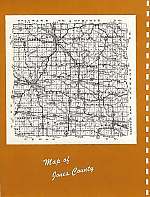 |
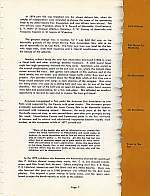 In 1874 new life was breathed into the almost defunct fair, when the articles of incorporation were amended to change the name of the sponsoring body to the Jones County Fair Association, and new officers were elected. The new officers were: President, Major S. S. Farwell of Monticello; Vice-President, E. V. Miller of Viroqua (Morley); Secretary, C. W. Gurney of Monticello and Treasurer, Captain A. M. Loomis of Wyoming. In 1874 new life was breathed into the almost defunct fair, when the articles of incorporation were amended to change the name of the sponsoring body to the Jones County Fair Association, and new officers were elected. The new officers were: President, Major S. S. Farwell of Monticello; Vice-President, E. V. Miller of Viroqua (Morley); Secretary, C. W. Gurney of Monticello and Treasurer, Captain A. M. Loomis of Wyoming.
The greatest change was in location, for it was held that year on the Monticello grounds of the Union Driving Park Association, later sold to the city of Monticello for its City Park. The forty acre tract was ideal for the fair with large trees, wide level expanses and a natural amphitheatre, adding to the beauty of the grounds. Starting without funds the new Fair Association borrowed $1800 to erect a Floral Hall and other buildings deemed necessary. A solid board fence eight feet high completely enclosed the forty acres. Spectators were seated in the natural amphitheatre, south of the one now in use, where the natural slope curves around the track. Ball games were played at this southern end of the track infield, but the batter and diamond faced north, rather than east as at present. Fair activities centered about the Floral Hall, which at that time was a large round structure with wings in each direction of the compass. One wing for many years was used as a dining hall, and was run by one of the local churches. The roof of the hall was an open air pavilion, where band concerts were held and promenading, for a fee, took place. This afforded an excellent opportunity to see and be seen and impress 'the best girl friend'. Anamosa reorganized a Fair under the Anamosa Fair Association so two Fairs were supported by the County with great rivalry. The Anamosa project eventually succumbed, while the Jones County Fair in its Monticello location continued with increasing success. However, the early years of the fair in Monticello were not easy, as rain poured down year after year promptly during fair week. Nevertheless County and Community pride in the Fair continued to increase and its cultural and educational importance became rapidly more evident, as this newspaper article of 1877 pointed out:
At the 1879 exhibition the Anamosa Art Association showed 131 paintings! Mrs. P. McCarn showed twenty-three works, Mrs. C. A. Lee showed twenty-seven, and Miss Tirzah Holt, thirteen. Others exhibiting were Mrs. J. S. Stacy, C. E. Littlefield, Misses Lou and Olie Shaw and Mrs. Nellie Gawley. Music was also featured that year as a $100 premium was offered for the best band playing. This inspired a great interest in band music, and fair goers were found to enjoy the bands equally as much as the exhibits. |
 |
||
 |
The public rose to the occasion. Mrs. James Davidson exhibited her collection of 225 house plants. (Fair visitors were also informed that she pursued church, Sunday school, and temperance work and debated literary and social questions besides caring for her home, family and houseplants.) J. W. Doxsee, editor of the local paper, cited a suit of lady's underclothing created by Mrs. S. R. Howard as probably the most elaborate piece on display. "The weakness of the sex for what is showy and fine in this class of drapery we could not understand," he wrote, "but it had fine illustration in the Floral Hall. But we can not particularize." It was felt that Floral Hall competition did much to nurture "that noblest flower grown on American soil - the rare and beautiful rose known as the American Woman." In support of these noble sentiments old timers recall a visitor from a nearby town who appeared in full dress suit, with boiled shirt, black bow tie and high silk hat. He had taken the outfit in on a horse trade and felt it proper costume for the Great Jones County Fair. Although the Fair had acquired a great deal of polish and culture, amphitheatre spectators, when seating themselves on the grass to watch the races, were ever alert to avoid the rinds from huge thirty cent watermelons sold on the grounds, a favorite dessert of fair picnickers. |
|||


© Copyright 1997-2013, The Art Department, © Copyright 2014-2020, Richard Harrison.
| ||||
